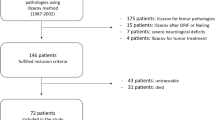Summary
From 04/91 to 06/96 sixty-nine open fractures of the tibia were primarily treated on the day of the accident with unreamed nailing (UTN, Synthes™). The distributions of fracture type according to the AO classification and of soft tissue injury according to Gustilo were as follows: fracture type: A: 28 %, B: 52 %, C: 20 %; soft tissue injury: I: 30 %, II: 28 %, IIIA: 12 %, IIIB: 12 %, IIIC: 6 %. Of the 65 fractures assessed 46 (71 %) healed within 18 weeks without secondary intervention. There was delayed healing in three fractures requiring secondary conversion to reamed nailing. Eight fractures (12 %) developed pseudarthrosis of which five (8 %) healed uneventfully. Deep infections was manifest in four fractures (6 %). Three of these infections developed after secondary intervention to treat pseudarthrosis. Seven of the eight pseudarthroses and three of the four infections healed eventually. Revision procedures were necessary in 11 patients (17 %) to deal with disturbed fracture healing or infection (10 reamed nailing procedures, three cancellous bone grafts, and one of each of the following: sequestrectomy, fibular osteotomy, plate fixation, external fixator, monorail procedure). The results show that the same good infection rates were achieved for the UTN as for the external fixator. The advantages of the UTN are, however, a lesser need for secondary intervention and greater patient comfort. Therefore, we find the UTN to be a good alternative to the external fixator in the treatment of open fractures with severe soft tissue damage.
Zusammenfassung
Zwischen 04/91 und 06/96 wurden 69 offene Unterschenkelfrakturen primär am Unfalltag mittels ungebohrter Marknagelung (UTN, Synthes™) versorgt. Die Verteilung des Frakturtyps (AO-Klassifikation) und Weichteilschadens (Gustilo) war wie folgt: Frakturtyp: A: 28 %, B: 52 %, C: 20 %. Weichteilschaden: I: 30 %, II: 28 %, IIIA: 12 %, IIIB: 12 %, IIIC: 6 %. Von 65 beurteilbaren Frakturen heilten 46 (71 %) ohne sekundäre Maßnahmen in 18 Wochen aus. Bei drei Frakturen kam es zur verzögerten Heilung, so daß ein Verfahrenswechsel zur aufgebohrten Marknagelung notwendig wurde; 8 Frakturen (12 %) entwickelten eine Pseudarthrose, wovon 5 (8 %) ohne weitere Komplikationen ausheilten. Bei 4 Frakturen (6 %) kam es zum tiefen Infekt; 3 der 4 Infekte entstanden nach Sekundäreingriffen zur Therapie einer Pseudarthrose; 7/8 der Pseudarthrosen und 3/4 der Infekte konnten zur Ausheilung gebracht werden. 2. Eingriffe waren bei 11 Patienten (17 %) aufgrund von Frakturheilungsstörungen oder Infekt notwendig (10 aufgebohrte Marknagelungen, 3 Spongiosaplastiken, je eine Sequestrektomie, Fibulaosteotomie, Plattenosteosynthese, Fixateur-externe-Anlage, Monorailverfahren). Die Ergebnisse zeigen, daß mit dem UTN gleich gute Infektraten, wie nach Fixateur externe Behandlung erreichbar sind. Vorteile des UTN ist jedoch eine geringere Rate an 2. Eingriffen bei größerem Patientenkomfort. Daher ist der UTN für uns eine gute Alternative zum Fixateur externe in der Behandlung von offenen Frakturen mit schwerem Weichteilschaden.
Similar content being viewed by others
Author information
Authors and Affiliations
Rights and permissions
About this article
Cite this article
Müller, C., Dietrich, M., Morakis, P. et al. Clinical results of the primary fixation of open tibial fractures treated with the unreamed AO/ASIF tibial nail. Unfallchirurg 101, 830–837 (1998). https://doi.org/10.1007/s001130050347
Published:
Issue Date:
DOI: https://doi.org/10.1007/s001130050347




